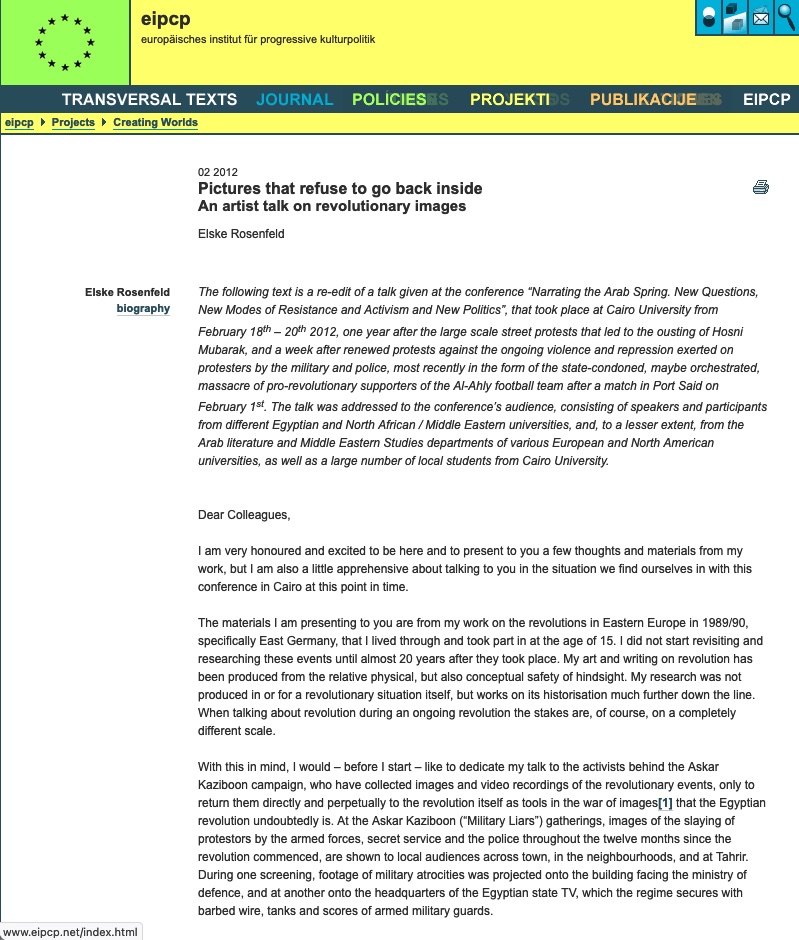Pictures that refuse to go back inside. An artist talk on revolutionary images

Download the full text HERE.
Cairo, February 2012
Dear Colleagues,
I am very honoured and excited to be here and to present to you a few thoughts and materials from my work, but I am also a little apprehensive about talking to you in the situation we find ourselves in with this conference in Cairo at this point in time.
The materials I am presenting to you are from my work on the revolutions in Eastern Europe in 1989/90, specifically East Germany, that I lived through and took part in at the age of 15. I did not start revisiting and researching these events until almost 20 years after they took place. My art and writing on revolution has been produced from the relative physical, but also conceptual safety of hindsight. My research was not produced in or for a revolutionary situation itself, but works on its historisation much further down the line. When talking about revolution during an ongoing revolution the stakes are, of course, on a completely different scale.
With this in mind, I would – before I start – like to dedicate my talk to the activists behind the Askar Kaziboon campaign, who have collected images and video recordings of the revolutionary events, only to return them directly and perpetually to the revolution itself as tools in the war of images[1] that the Egyptian revolution undoubtedly is. At the Askar Kaziboon (“Military Liars”) gatherings, images of the slaying of protestors by the armed forces, secret service and the police throughout the twelve months since the revolution commenced, are shown to local audiences across town, in the neighbourhoods, and at Tahrir. During one screening, footage of military atrocities was projected onto the building facing the ministry of defence, and at another onto the headquarters of the Egyptian state TV, which the regime secures with barbed wire, tanks and scores of armed military guards.
The activists’ conscious, strategic, and courageous use of images makes them performative in, rather than representative of the revolution, and conflates and integrates art and politics in a way that is, I suppose, the horizon (often the far horizon) of much of the art produced in the Western political art scenes and certainly of my own work with revolutionary images.
[...]
What has impressed me so deeply about the events in Egypt over the last weeks and months, is the wisdom and persistence with which the revolutionaries, returning again and again to Tahrir and to the streets, have worked at the precise point where rupture comes to be sutured up into order and status quo once more. Practices, such as the Askar Kaziboon, have done something very similar on the level of images and narratives, breaking them free from those processes in which they, too, are set to be ordered, identified, assigned their place, and closed off. By using the images in such a way, they help to keep open, rather than closing down a continuing space of political potentiality.
[...]
Exerpts from a talk given by Elske Rosenfeld at the conference “Narrating the Arab Spring. New Questions, New Modes of Resistance and Activism and New Politics”, that took place at Cairo University from February 18th – 20th 2012, one year after the large scale street protests that led to the ousting of Hosni Mubarak, and a week after renewed protests against the ongoing violence and repression exerted on protesters by the military and police, most recently in the form of the state-condoned, maybe orchestrated, massacre of pro-revolutionary supporters of the Al-Ahly football team after a match in Port Said on February 1st. The talk was addressed to the conference’s audience, consisting of speakers and participants from different Egyptian and North African / Middle Eastern universities, and, to a lesser extent, from the Arab literature and Middle Eastern Studies departments of various European and North American universities, as well as a large number of local students from Cairo University.